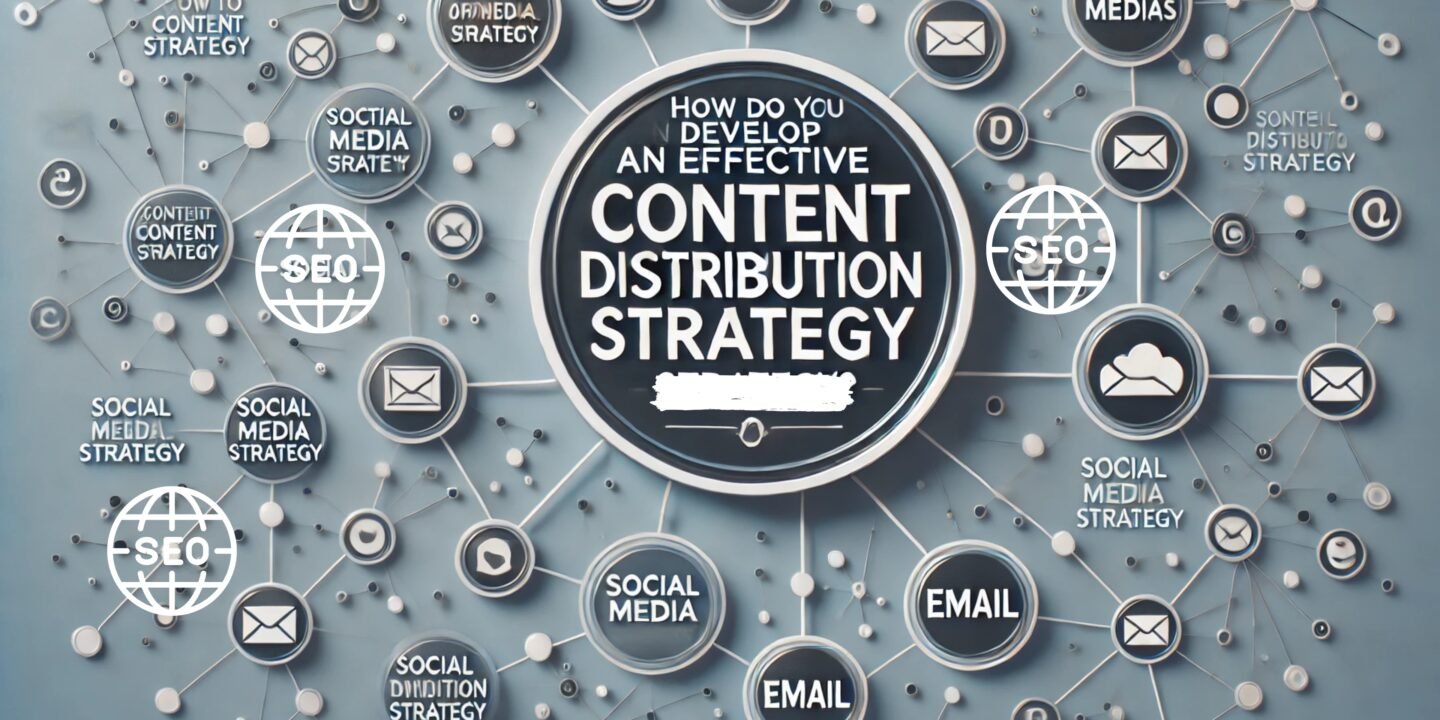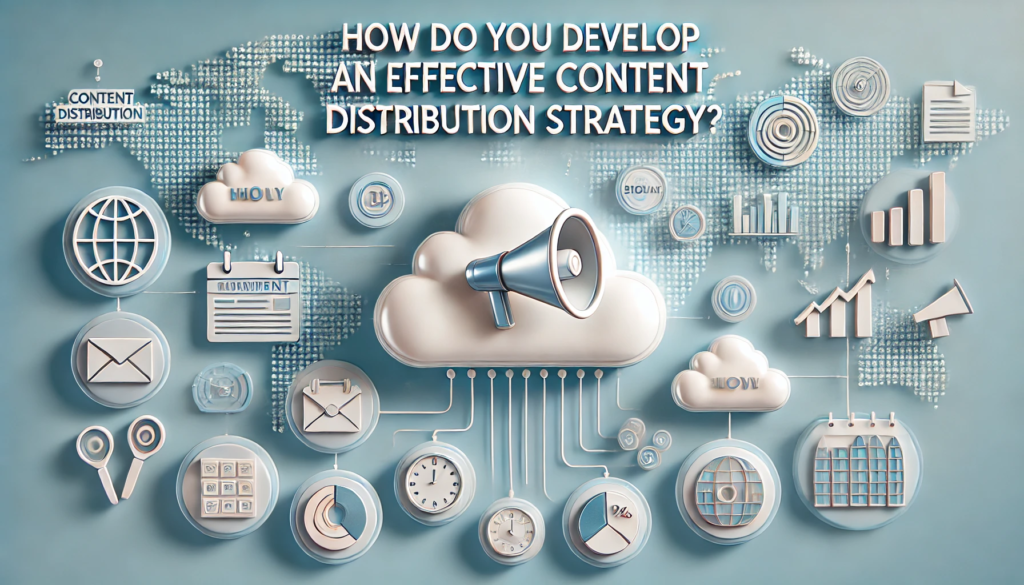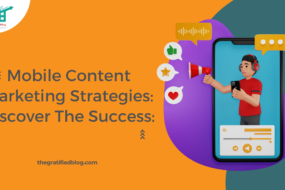
Creating great content is just the beginning; effectively distributing it is crucial for reaching your audience and achieving your goals. Developing an effective content distribution strategy ensures your content gets the visibility it deserves across multiple channels. From social media and email campaigns to influencer partnerships and paid promotions, a well-crafted strategy leverages various platforms to amplify your message.
This blog, “How do you develop an effective content distribution strategy?” will help you understand the vital elements of content distribution, including audience targeting, channel selection, and performance tracking, so you can maximise your content’s impact and drive meaningful engagement with your audience.
What Is Content Distribution, And Why Is It Important?

Content distribution is the process of sharing, publishing, and promoting content through various channels to reach a wider audience. It’s essential because even the best content can go unnoticed without a solid distribution plan. Effective distribution amplifies your content’s reach, boosts engagement, and helps achieve marketing objectives such as brand awareness, lead generation, and customer retention.
What Are The Different Types Of Content Distribution Channels?
Content distribution channels can be broadly categorised into three main types: owned, earned, and paid.
- Owned Channels: These are platforms and media that a business directly controls. Examples include a company’s website, blog, email newsletters, and social media profiles. Content distributed through owned channels is typically cost-effective and allows complete control over the message and timing.
- Earned Channels: These involve third-party platforms where others share your content without direct payment. This includes press coverage, guest posts, reviews, and shares or mentions on social media by influencers and customers. Earned channels are valuable for their credibility and organic reach, as the content is shared because it is deemed valuable or noteworthy.
- Paid Channels: These require monetary investment to distribute content. Examples include pay-per-click (PPC) advertising, social media ads, sponsored posts, and display ads. Paid channels can offer rapid reach and precise targeting, making them effective for driving immediate traffic and conversions.
Utilising a mix of these channels ensures a comprehensive content distribution strategy, maximising reach and engagement by leveraging the strengths of each type.
How Do You Develop An Effective Content Distribution Strategy?

Content creation is only half the battle in a successful digital marketing strategy. The other half is ensuring that your content reaches the right audience. This is where a robust content distribution strategy comes into play. An effective content distribution strategy ensures that your target audience sees, reads, and acts upon your carefully crafted content. Here’s a comprehensive guide on how to develop an effective content distribution strategy.
Setting Clear Objectives
Every successful strategy starts with clear objectives. What do you want to achieve with your content distribution? Your goals could include:
- Increasing brand awareness
- Driving traffic to your website
- Generating leads
- Boosting sales
- Enhancing customer engagement
Your objectives should be specific, measurable, attainable, relevant, and time-bound (SMART). For example, instead of saying, “I want more website traffic,” a SMART objective would be, “I aim to increase website traffic by 20% over the next three months.”
Knowing Your Audience
An effective content distribution strategy hinges on deeply understanding your target audience. You need to know who they are, what they want, where they spend their time online, and how they consume content. Create detailed buyer personas that include:
- Demographics: Age, gender, income, education, etc.
- Psychographics: Interests, hobbies, values, lifestyle, etc.
- Online Behavior: Preferred social media platforms, types of content they engage with, etc.
- Pain Points: Challenges and problems your audience is facing
These personas will guide your content creation and distribution efforts, ensuring your content resonates with your audience and reaches them through the right channels.
Creating High-Quality Content
Quality content is the cornerstone of any effective content distribution strategy. Your content should be valuable, relevant, and engaging to your audience. An example of an effective content piece is one that provides insightful information while being easy to understand and captivating for the reader. Here are some tips for creating high-quality content:
- Focus on Value: Provide solutions to your audience’s problems. Educational, informative, and valuable content is more likely to be shared and engaged with.
- Be Original: Offer unique insights and perspectives. Original content stands out and establishes your authority.
- Maintain Consistency: Consistent posting schedules help keep your audience engaged and returning for more.
- Optimise for SEO: Use relevant keywords, meta descriptions, and alt text to improve your content’s visibility on search engines.
- Use Visuals: Incorporate images, infographics, and videos to make your content more engaging and shareable.
Choosing The Right Distribution Channels
With your objectives, audience, and content in place, choosing the right distribution channels is time. Not all channels will be suitable for every type of content or audience. Here’s a breakdown of some popular distribution channels and their best uses:
- Social Media: Ideal for engaging with your audience and sharing various types of content, from blog posts to videos and infographics. Different platforms serve different purposes:
- Facebook: Great for a wide range of content, including articles, videos, and community engagement.
- Instagram: Best for visual content like images, short videos, and stories.
- LinkedIn: Perfect for B2B content, professional insights, and industry news.
- Twitter: Suitable for quick updates, news, and engaging with a tech-savvy audience.
- TikTok: Excellent for short, engaging videos aimed at younger demographics.
- Email Marketing: An effective way to distribute content directly to your audience. Use newsletters to share blog posts, updates, and exclusive content.
- Content Syndication: Publishing your content on third-party sites to reach a broader audience. Consider platforms like Medium, LinkedIn Pulse, and industry-specific blogs.
- Guest Blogging: Write articles for other blogs in your industry to reach their audience and build backlinks to your site.
- Influencer Partnerships: Collaborate with influencers to promote your content to their followers.
- Paid Advertising: Use PPC, social media ads, and sponsored content to amplify your reach.
Leveraging SEO For Organic Reach
Search engine optimisation (SEO) is crucial for maximising the organic reach of your content. Here are some SEO best practices:
- Keyword Research: Identify and use relevant keywords that your target audience is searching for.
- On-Page SEO: Optimize your titles, headers, meta descriptions, and images with keywords.
- Internal Linking: Link to other relevant content on your site to improve navigation and SEO.
- External Linking: Include links to high-authority sites to enhance credibility and SEO.
- Content-Length: Longer, in-depth content performs better in search rankings.
- Mobile Optimization: Ensure your content is mobile-friendly, as many users access content via mobile devices.
- Page Speed: Optimize your site’s loading speed to enhance user experience and SEO rankings.
Utilising Analytics and Feedback
Tracking and analysing the performance of your content distribution efforts is vital for continuous improvement. Use analytics tools like Google Analytics, social media insights, and email marketing reports to monitor:
- Traffic sources
- Engagement metrics (likes, shares, comments)
- Conversion rates
- Bounce rates
- Audience demographics
Additionally, gather feedback from your audience through comments, surveys, and direct interactions. This information will help you understand what’s working, what’s not, and how to improve your strategy.
Adjusting and Optimizing Your Strategy
Content distribution is not a set-it-and-forget-it task. It requires continuous adjustment and optimisation based on performance data and audience feedback. Here are some tips for ongoing optimisation:
- A/B Testing: Experiment with headlines, formats, and distribution times to see what performs best.
- Repurpose Content: Turn high-performing content into different formats, such as a blog post, a video, or an infographic.
- Update Old Content: Refresh and republish outdated content to keep it relevant and improve performance.
- Engage with Your Audience: Respond to comments and engage with your audience to build relationships and encourage more interaction.
Collaborating with Influencers and Partners
Influencer marketing and partnerships can significantly amplify your content distribution efforts. Influencers have established audiences that trust their recommendations. Partnering with influencers and industry leaders can help you reach a wider audience and build credibility. Here’s how to leverage influencer marketing:
- Identify Relevant Influencers: Look for influencers in your industry whose audience aligns with your target market.
- Build Relationships: Engage with influencers by sharing their content, commenting on their posts, and reaching out directly.
- Create Valuable Partnerships: Collaborate on content creation, such as guest posts, joint webinars, or co-branded content.
- Monitor and Measure: Track your influencer collaborations’ performance to ensure they meet your objectives.
Embracing New Technologies and Trends
The digital landscape constantly evolves, and staying ahead of new technologies and trends can give you a competitive edge. Here are some emerging trends to consider:
- Artificial Intelligence (AI): Use AI tools for content creation, personalisation, and distribution. AI can help you create more targeted and relevant content for your audience.
- Voice Search Optimization: With the rise of voice assistants like Alexa and Siri, optimising your content for voice search is becoming increasingly important.
- Interactive Content: Engage your audience with interactive content such as quizzes, polls, and infographics.
- Video Content: Video continues to dominate as a preferred content format. Incorporate more video content into your distribution strategy.
- Personalisation: Use data and AI to personalise content and distribution to individual user preferences and behaviours.
Ensuring Consistency and Cohesion
Consistency and cohesion are key to a successful content distribution strategy. Ensure that your content and messaging are consistent across all distribution channels. Here’s how to maintain consistency:
- Brand Guidelines: Create and adhere to guidelines that outline your tone, style, and visual elements.
- Content Calendar: Plan and schedule your content distribution using a content calendar. This ensures a steady flow of content and avoids last-minute scrambling.
- Cross-Promotion: Promote your content across different channels to maximise reach. For example, share a blog post on social media and include it in your email newsletter.
Measuring ROI and Success Metrics
Ultimately, the success of your content distribution strategy depends on its ability to achieve your business objectives. Measuring return on investment (ROI) and success metrics is crucial. Here are some key metrics to track:
- Traffic: Monitor the number of visitors to your website from different distribution channels.
- Engagement: Track likes, shares, comments, and other forms of engagement on your content.
- Leads and Conversions: Measure the number of leads and conversions generated from your content.
- Sales: Track sales and revenue generated from your content distribution efforts.
- Brand Awareness: Use tools like social listening to measure brand mentions and sentiment.
What Tools Can Help in Content Distribution?
Various tools can streamline your content distribution efforts and enhance efficiency. Consider using:
Content distribution is crucial for maximising the reach and impact of your content. Here are some effective tools to help streamline and enhance your content distribution strategy:
- Social Media Management Tools: Platforms like Hootsuite, Buffer, and Sprout Social allow you to schedule and automate posts across multiple social media channels. They also provide analytics to track engagement and optimise your strategy.
- Email Marketing Software: Tools like Mailchimp, Brevo, and Constant Contact help distribute your content directly to subscribers. They offer segmentation features, automation, and detailed performance metrics.
- Content Discovery and Curation Tools: Use platforms like Scoop.it, BuzzSumo, and Feedly to discover trending content and curate it for your audience. These tools help keep your content relevant and engaging.
- Content Syndication Networks: Outbrain and Taboola are popular for promoting content across various websites. They increase visibility by placing your content in front of a broader audience.
- SEO Tools: Tools like Ahrefs, SEMrush, and Moz help optimise your content for search engines, making it easier to discover. They offer keyword research, backlink analysis, and site audits.
- Project Management Tools: Trello, Asana, and Monday.com help organise and track your content distribution efforts, ensuring timely and consistent delivery across all channels.
Using these tools, you can effectively manage, automate, and optimise your content distribution, enhancing your reach and engagement.
What Are the Legal and Ethical Considerations in Content Distribution?
Ensuring legal and ethical compliance is crucial in content distribution. Consider the following:
- Copyright Compliance: Ensure content respects intellectual property rights and has proper attributions.
- Privacy Laws: Data protection regulations like GDPR and CCPA should be used when handling personal information.
- Transparency: Disclose sponsored content and affiliate links to maintain trust.
- Content Accuracy: Verify information to avoid spreading misinformation or fake news.
- Consent: Obtain necessary permissions to use third-party content or personal data.
- Accessibility: Make content accessible to all users, including those with disabilities.
- Fair Use: Understand and apply fair use principles appropriately.
By adhering to these considerations, content distributors can maintain legal compliance and uphold ethical standards, fostering trust and credibility with their audience.
How Do You Ensure Long-Term Success in Content Distribution?
Achieving long-term success in content distribution requires continuous improvement and adaptation. Here’s how:
- Quality Content Creation: Always prioritise creating high-quality, valuable content that resonates with your target audience. This builds trust and encourages sharing.
- Audience Research: Understand your audience’s preferences, pain points, and content consumption habits. Tailor your content and distribution strategies accordingly.
- Diverse Distribution Channels: Utilize a mix of distribution channels, including social media, email marketing, SEO, and paid advertising, to reach a wider audience and mitigate risks associated with platform dependency.
- Consistent Publishing Schedule: Maintain a consistent content calendar to keep your audience engaged and anticipate new content. Consistency helps in building a loyal following.
- SEO Optimization: Optimize your content for search engines to ensure it reaches the right audience organically over time. This includes keyword research, on-page SEO, and backlink building.
- Performance Monitoring: Regularly track and analyse your content performance using analytics tools. This helps identify what’s working what needs improvement, and guides future content strategies.
- Audience Engagement: Actively engage with your audience through comments, social media interactions, and feedback. Building relationships fosters loyalty and encourages word-of-mouth distribution.
- Adaptability: Stay updated with industry trends and be ready to adapt your strategies as needed. Flexibility is crucial in responding to changing audience behaviours and market dynamics.
Focusing on these key points can ensure sustained success in your content distribution efforts, driving long-term growth and engagement.
Conclusion
In conclusion, developing an effective content distribution strategy is essential for maximising the reach and impact of your content. By understanding your audience, leveraging various distribution channels, and consistently analysing performance metrics, you can ensure your content reaches and engages your target audience.
Stay adaptable, continually refine your strategy based on feedback and data, and keep abreast of emerging trends to stay ahead in the competitive content landscape. A well-crafted distribution plan can significantly enhance your content’s visibility, drive traffic, and contribute to overall marketing goals.








No Comments